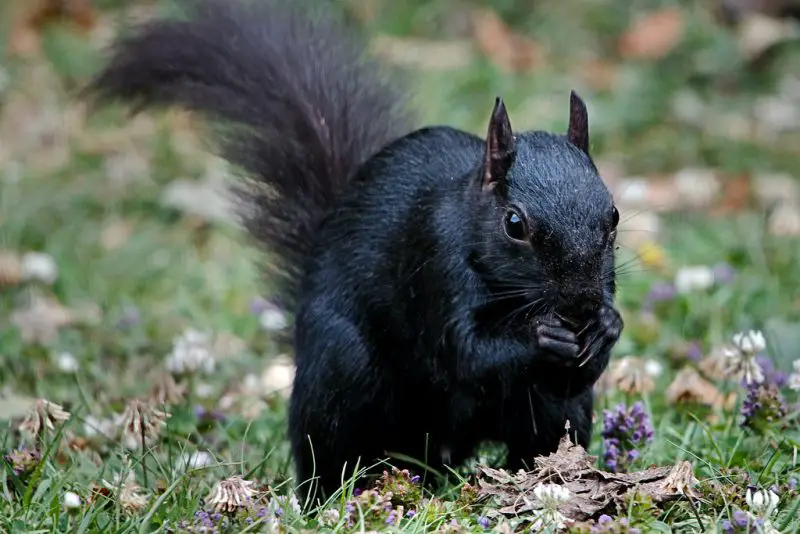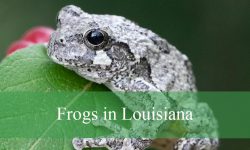If you’ve ever walked through a Michigan park in autumn, you’ve probably seen the usual brown and gray squirrels leaping from tree to tree. But once in a while, something unusual catches your eye—a squirrel with sleek, jet-black fur. These black squirrels in Michigan are more than just a striking variation; they are a fascinating product of genetics, history, and adaptation.
Black squirrels have become something of a local treasure in certain Michigan communities. They are rare enough to spark curiosity but common enough in specific areas to become part of the local identity. Understanding their story means diving into a blend of biology, ecology, and a dash of folklore. From their origins to their behavior, and from the science of their color to the cultural significance they hold, black squirrels are far more than a simple genetic twist—they are a living mystery.
The Origins of Black Squirrels in Michigan

Historical Accounts and Early Sightings
While Michigan is home to multiple squirrel species, the black squirrel is most often a color morph of the eastern gray squirrel (Sciurus carolinensis) or the fox squirrel (Sciurus niger). Historical records suggest that black squirrels were present in parts of North America for centuries before European settlement. Trappers and naturalists in the 1800s reported spotting these dark-coated animals, especially in densely forested areas where their dark fur offered camouflage.
In Michigan, early sightings were concentrated in the mid-to-late 1800s, particularly in wooded regions along the Lower Peninsula. Communities such as Kent, Midland, and Battle Creek became known for their higher-than-average black squirrel populations. Over time, these animals became emblematic of certain towns, even influencing local mascots and souvenirs.
The Role of Canadian Connections
Some wildlife historians believe Michigan’s black squirrels may have roots in populations from Ontario, Canada. Anecdotal accounts claim that in the late 1800s and early 1900s, black squirrels were intentionally released in some Michigan towns as part of local wildlife management or beautification projects. Whether or not these stories are entirely accurate, they do align with genetic evidence showing close ties between Michigan and Ontario black squirrel populations.
Genetics Behind the Black Fur
Melanism Explained
The striking black coat of these squirrels is caused by a genetic condition called melanism, which results from an excess of the pigment melanin. In squirrels, melanism is often linked to a mutation in the MC1R gene. This mutation can be dominant or recessive depending on the species and population, which means that two gray squirrels carrying the melanistic gene can produce black offspring.
Melanism isn’t exclusive to squirrels; it also appears in other mammals, birds, and reptiles. In squirrels, it’s not just about appearance—it can offer survival advantages. Darker fur absorbs more heat, which can be beneficial during Michigan’s cold winters. It can also make squirrels less visible to predators in shaded forest environments.
Black Squirrels vs. Gray and Fox Squirrels
In Michigan, black squirrels are usually either a melanistic morph of the eastern gray squirrel or the fox squirrel. Eastern gray squirrels typically weigh 1–1.5 pounds, with a body length of about 9–12 inches and a tail of similar length. Fox squirrels are larger, averaging 1.5–2.5 pounds, and their black morphs can sometimes have a slightly reddish or brownish tinge under the fur.
Distribution of Black Squirrels in Michigan
Hotspots for Black Squirrel Sightings
Black squirrels aren’t evenly spread across Michigan. Certain towns and cities have unusually high concentrations, while in other areas they are almost nonexistent. Places like Battle Creek, Kent, and East Lansing are well-known black squirrel hubs.
Urban parks and suburban neighborhoods with large oak, walnut, and maple trees often support thriving squirrel populations, including the black morph. College campuses, particularly those with established tree cover and minimal hunting pressure, have become reliable places to see them. Michigan State University and Albion College, for instance, are known for their black squirrel sightings.
Factors Affecting Their Range
Habitat plays a major role in where black squirrels thrive. They are more common in areas with mixed hardwood forests and plentiful food sources. Urbanization can sometimes help, as cities offer fewer natural predators and consistent food supplies from bird feeders and human waste. However, too much development can fragment their habitat, limiting their spread.
Behavior and Daily Life of Black Squirrels
Foraging and Diet
Like their gray and fox squirrel relatives, black squirrels in Michigan are omnivorous foragers. Their diet mainly consists of acorns, walnuts, hickory nuts, maple seeds, and other tree-based foods. In summer, they may also eat fruits, berries, fungi, and even small insects. During the fall, their activity peaks as they gather and bury nuts for the winter—a behavior known as caching.
Their dark fur can give them a slight edge in cooler months, allowing them to stay active longer during cold mornings. This means they might be seen foraging earlier in the day than their lighter-colored counterparts.
Nesting and Social Behavior
Black squirrels build nests called dreys high in the branches of tall trees, using leaves, twigs, and shredded bark. In colder months, they may take shelter in tree cavities, which offer better insulation. While squirrels are not truly social animals, black squirrels tolerate the presence of others, especially in food-rich areas. However, territorial disputes can occur, often involving chasing and vocal scolding.
The Cultural Significance of Black Squirrels in Michigan
Mascots and Local Pride
Several Michigan towns have adopted the black squirrel as an unofficial symbol. Albion, for example, has an annual Black Squirrel Day celebrating their unique local wildlife. This cultural embrace has turned the black squirrel from a genetic curiosity into a point of civic pride.
Black squirrels have also made their way into university folklore, sports mascots, and even tourism marketing. Souvenir shops in certain towns sell black squirrel mugs, shirts, and stuffed animals.
Folklore and Myths
Folklore surrounding black squirrels in Michigan ranges from the humorous to the mythical. Some stories claim they were specially bred and released to control other squirrel populations. Others suggest they were gifts from visiting dignitaries or exotic animals imported from distant lands. While most of these tales are unverified, they contribute to the mystique and charm of these dark-furred creatures.
Advantages and Disadvantages of Being Black
Survival Benefits
The most obvious potential advantage of being black is thermoregulation. In Michigan’s snowy winters, the black fur absorbs more sunlight, helping squirrels stay warmer. Additionally, their coloration can provide better camouflage in dense evergreen forests or shaded woodlands.
Potential Drawbacks
The same dark coat that offers warmth can also be a disadvantage in open areas during summer, as it may lead to overheating. In snowy environments, black squirrels are more visible to predators like hawks and owls compared to gray squirrels, which blend in better with the snow-covered landscape.
Conservation Status and Future Outlook
Population Stability
Black squirrels in Michigan are not considered endangered or threatened. In fact, in areas where they are common, their numbers seem to be stable or even increasing. Their adaptability to urban environments helps ensure their survival.
Human Impact and Protection
While black squirrels face threats from habitat loss, road traffic, and predation, they benefit from living near humans. Communities that value their presence often take steps to protect them, such as maintaining green spaces and discouraging hunting in urban areas. The affection many Michiganders have for black squirrels ensures they will remain a familiar sight in certain regions for years to come.
Fun Facts About Black Squirrels in Michigan
Unexpected Behaviors
Black squirrels have been known to raid bird feeders, stash food in flower pots, and occasionally nest in attics or garages if they find easy access. Despite their boldness, they remain quick and agile, darting away at the first sign of danger.
Genetic Mixes and Hybrids
Sometimes, black squirrels in Michigan produce offspring with gray or brown coats, depending on their mate’s genetics. This mixing of colors keeps the local squirrel populations genetically diverse.
Conclusion
Black squirrels in Michigan are more than just an unusual sight in the treetops. They are a blend of genetic happenstance, environmental adaptation, and human fascination. Their history stretches back long before modern cities, yet they’ve adapted seamlessly to suburban parks and college campuses.
For many Michiganders, spotting a black squirrel is a small but delightful reminder of the state’s rich wildlife diversity. Whether they’re bounding across snowy lawns, foraging in autumn leaves, or peeking from behind a tree trunk, these ebony-coated acrobats continue to spark curiosity and admiration. And while their origins may be partially shrouded in mystery, one thing is certain: Michigan would be a little less magical without them.
FAQs About Black Squirrels in Michigan
What Are Black Squirrels?
Black squirrels are a melanistic color variant of the eastern gray squirrel or fox squirrel. Their dark fur is caused by a genetic mutation that increases melanin production, giving them their distinctive black appearance.
Where Can I See Black Squirrels in Michigan?
Black squirrels are most commonly found in towns and cities with abundant tree cover, such as Battle Creek, Kent, East Lansing, and Albion. They thrive in parks, suburban neighborhoods, and college campuses where food sources are plentiful.
Are Black Squirrels a Separate Species?
No, black squirrels are not a separate species. They are the same species as eastern gray or fox squirrels but with a melanistic color morph. Their unique coloration does not affect their behavior or diet significantly.
Why Are Black Squirrels Rare?
Black squirrels are less common because the melanistic gene is not present in all populations. Their prevalence depends on historical introductions, genetic variation, and survival advantages in certain environments.
Do Black Squirrels Have Different Behaviors Than Gray Squirrels?
Generally, black squirrels behave like gray or fox squirrels. They forage for nuts, fruits, and insects, build nests in trees, and cache food for winter. However, their dark fur may help them stay warmer in cold weather, giving them a slight advantage in winter activity.
Can Black Squirrels Survive Michigan Winters?
Yes, black squirrels are well-adapted to Michigan winters. Their thick fur provides insulation, and they rely on cached food to survive when resources are scarce. Their melanism may even help them absorb more heat from sunlight during cold days.
Are Black Squirrels Protected by Law in Michigan?
Black squirrels are not endangered or specifically protected. However, they benefit from general wildlife protections and the fact that many Michiganders value their presence, leading to safer urban and suburban habitats.
Why Are Black Squirrels Considered a Mystery?
The combination of their rare coloration, localized populations, and cultural significance makes black squirrels a fascinating and mysterious part of Michigan’s wildlife. Their origins, spread, and genetic traits continue to intrigue scientists and residents alike.






